Broadcast Moving Forward
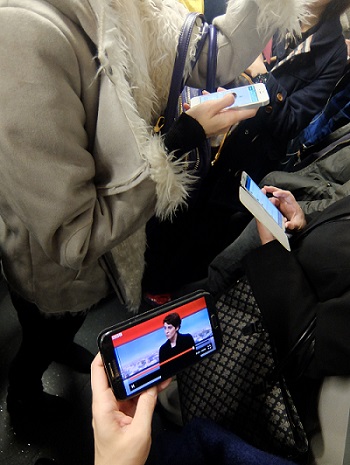
Who will benefit from the money mobile viewers will eventually pay for the service? The FORECAST’13 seminar staged by the European Broadcasting Union late last year focused as usual on what the future might hold for broadcast technologies. This time, the event’s headline – Mission Critical for Public Service Media -- warned about the potential seriousness of the situation for broadcasters.
The event at EBU headquarters in Geneva was well-attended. More than 110 delegates from broadcasters, network operators, manufacturers, national regulators, policymakers and research labs attended.
FORECAST ‘13 opened with a reminder of why the discussions about spectrum use and broadcast technologies are so important. The reason: Recent World Radiocommunication Conferences (WRC) have resulted in a potentially progressive reduction path in the spectrum available for broadcasting.
EBU Media Director Annika Nyberg Frankenhaeuser, in her keynote presentation, reminded the delegates that the EBU's mission is to make Public Service Media indispensable. She also stressed the importance of a sustainable terrestrial platform in making this indispensability a reality.
Many EBU members rely on digital terrestrial emissions to fulfill their statutory universal coverage, with guaranteed quality of service and free-to-air accessibility. The time has come to consider how to secure the future of digital terrestrial platforms.
The 800 MHz band has already been cleared in Europe for mobile telecommunications and, following last year's decision at WRC-12, the 700 MHz band is set to follow a similar path in many countries. According to the EBU, any further erosion of the spectrum available for broadcasting would significantly constrain the ability of DTT to compete and to develop in the future.
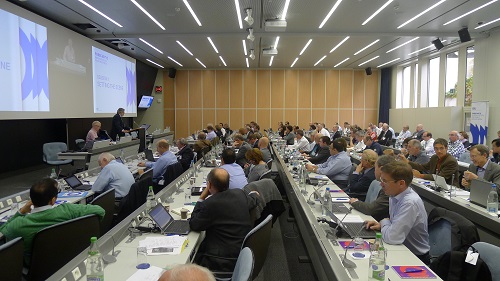
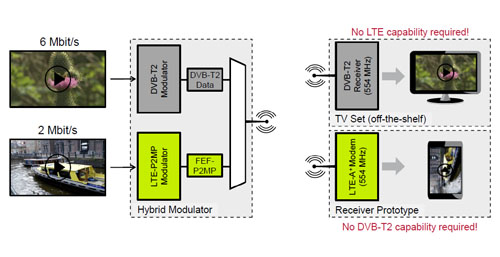
A “tower overlay” hybrid future could allow a profitable re-use of existing broadcast networks, where (international) frequency co-ordination was already done. Technology convergence actually means more divergence in distribution for EBU members: More platforms to cover, more types of service to produce and more costs – and all with less funding.
Get the TV Tech Newsletter
The professional video industry's #1 source for news, trends and product and tech information. Sign up below.
But this is just the lesser threat: Still accustomed to being the incumbent parties safely within their allocated ‘home range’ – that is, their spectrum -- broadcasters need to accept that nowadays there is no safe home range. Moreover, the ever-increasing pressure on spectrum from mobile services is something broadcasters can no longer address simply through technological solutions.
Speakers called on the broadcasters present to make their voices heard more loudly at the World Radiocommunication Conferences that decide such matters, and the national administrations who are represented there. There is a strong alliance pushing for more spectrum for wireless broadband -- broadcasters need to work hard to balance this. "If you don't use it, you will lose it,” was the message at FORECAST’13
Other items were raised at the EBU session. For instance, broadcast technology is evolving faster than ever, and many questions are on the table. Distribution networks can approach the theoretical limit of what’s possible, but end-user receivers are beyond public service broadcasters’ control.
UHDTV is now possible on distribution networks. But will consumers replace their legacy receivers way before UHDTV2 becomes a must on the production/distribution side?
Lots of discussion focused on content consumption on mobile devices. While all seemed to agree on the importance of the issue, the open question still is: Who will benefit from the money mobile viewers will eventually pay for the service?
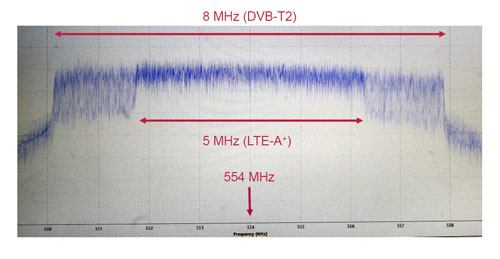
Tower overlay demo, spectrum Currently, end users are typically charged a monthly fee for a mobile data plan: Will broadcasters be entitled to share the revenues generated through their content? Will they run their own mobile viewing system? Or will the mobile business model remain as it now is?
Anyway, the audience agreed that broadcasters must have a role to play in meeting the demand of wireless data delivery in the future.
Hybrid Network Possibilities
Day Two opened with an examination of the concept of hybrid networks, where a combination of broadcast and mobile broadband techniques might deliver efficiencies and the 'best of both worlds.’
By focusing on common user cases – VOD, tablet/smartphones viewing, portable reception -- Sudewestrundfunk’s Dr. Roland Beutler tried to correlate broadcasters’ expectations (unlimited audience, linear and nonlinear viewing, QoS, some free-to-air channels, mobile reception) with the possibilities currently offered by available technologies.
Dr. Beutler pointed out that there is no “single” platform capable of satisfying each key requirement demanded by both end users and broadcasters. Moreover, the total amount of data delivered via broadcast networks in 2012 was about six times greater than the total amount of data delivered via fixed+mobile broadband in 2012.
In 2017, it is expected to be about three times greater than the forecasted fixed+mobile broadband data volume; assuming the total data delivered via broadcast will not increase in these five years. So the convergence of content to a single delivery platform is far away.
DigiTAG DVB-T2 Event
DigiTAG (Digital Terrestrial Television Action Group), the organisation bringing together stakeholders from the Digital Terrestrial Television (DTT) industry, held a workshop on DVB-T2 in Istanbul late last year as well.
Turkey launch in December, beginning in the capital Ankara, with region-by-region launches and approximately six-month analogue simulcast. The analogue switch-off is scheduled for March 3, 2015.
About 160 delegates from Europe, Eastern Europe and Asia heard from local industry players such as RTUK (Turkey’s regulator), TRT (public broadcaster), Anten AS (network operator) and the commercial broadcasters associations TVYD and RATEM, speaking on introducing DTT using the DVB-T2 standard.
“Turkey is at a delicate phase of the launch of DTT,” said Taha Yucel, RTUK’s Deputy President. “However ,this workshop has shown the positive developments in other markets. We must move forward as it is important that Turkey goes digital. There is no future for analogue. There is the possibility to make digital terrestrial television a success, and we should take this opportunity.”
A broad range of speakers from the DigiTAG membership shared their experiences in markets where DVB-T and DVB-T2 have been established. Lessons learned included the need for an inter-operability testing environment, interactive standards such as HbbTV, detailed coverage maps, and taking advantage of the flexibility made possible by the DVB-T2 standard (mobile and multiple local regional services included).
The need for a flexible environment, where channels can be shuffled and multiplexes restructured in the future as technology develops, was also a key area for discussion.
"It is exciting to see the broad range and diversity of DVB-T2 deployments throughout the world,” said Simon Fell, the EBU’s Director of Technology and Innovation, and DigiTAG’s President. “The DigiTAG Workshop in Istanbul is an ideal opportunity for members of DigiTAG and others to bring this experience together for Turkish colleagues who can benefit from the developments that have taken place elsewhere, as they prepare for DVB-T2 services throughout Turkey.”
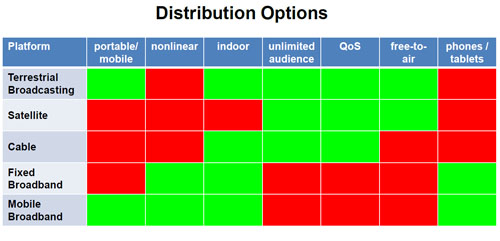
Content distribution options
According to Dr. Beutler, integrating multiple platforms in order to maximise consumers’experience and seamless availability of content could be the solution. Driving tablet and smartphone manufacturers to integrate broadcast receivers into their devices is one possible solution. In-home re-transmitting of broadcast content via Wi-Fi is probably a more viable one. In any case, “there is no one-fits-all solution,” concluded Dr. Beutler.
Frieder Juretzek from the Technical University of Braunschweig spoke about the latest developments achieved at his institute with respect to hybrid network innovations.
According to Juretzek, cellular networks will probably not be able to cope with the growing demand for “live” data (like live video) and will not be efficient to distribute live video and audio at “tablet quality” (1.4 Mbps or more) in thousands of networks cells, and possibly by several mobile network operators in parallel.
To remedy this, T.U. Braunschweig’s researchers imagined using DVB-T2 as the physical layer to carry LTE point-to-multipoint (P2MP) carrier traffic. DVB-T2 Future Extension Frames (FEF) would enable time domain spectrum sharing with other wireless networks, like LTE. Variable length and number of both frame types (DVB-T2 and FEF) would also enable flexible resource allocation, through cooperative spectrum use by terrestrial broadcast and mobile access networks.
This “tower overlay” hybrid future could allow a profitable re-use of existing broadcast networks, where (international) frequency co-ordination was already done. It would be an attractive approach for today´s broadcast network operators, as well as a joint resource for the operators of cellular networks; or a country-wide network provided by an independent (broadcast) network operator.
At IBC 2013, T.U. Braunschweig showcased a demo where a 6 Mbps broadcast video stream was managed as a standard DVB-T2 content and a 2 Mbps mobile targeted video was managed as a LTE-P2MP one.
One hybrid modulator blended the two streams using DVB-T2 FEF capabilities, and a DVB-T2 transmitter was airing them on UHF channel 31 (554 MHz). On the receiver side, one off-the-shelf TV displayed the broadcast-quality content, while a LTE-A prototype receiver (with no DVB-T2 capability) did the same with the mobile-targeted content.
In her closing remarks, the EBU’s Elena Puigrefagut wrapped up the seminar. Assuming that a sustainable DTT future requires certainty of spectrum availability, it’s key to strengthen the horizontal market: consumer electronic manufacturers, content owners, platform owners and operating system designers should all work together, she said.
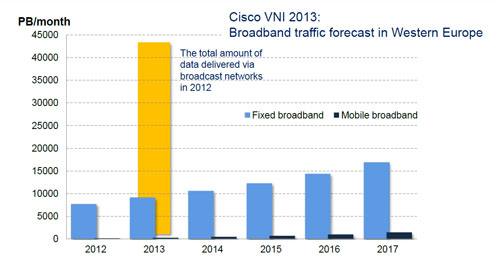
Western Europe broadband traffic forecast for 2013 Broadcasters’ voices should be louder, to reach European and international regulators but also national regulators: “We do a lot of technical work, but not enough on political lobbying!” Puigrefagut concluded.
